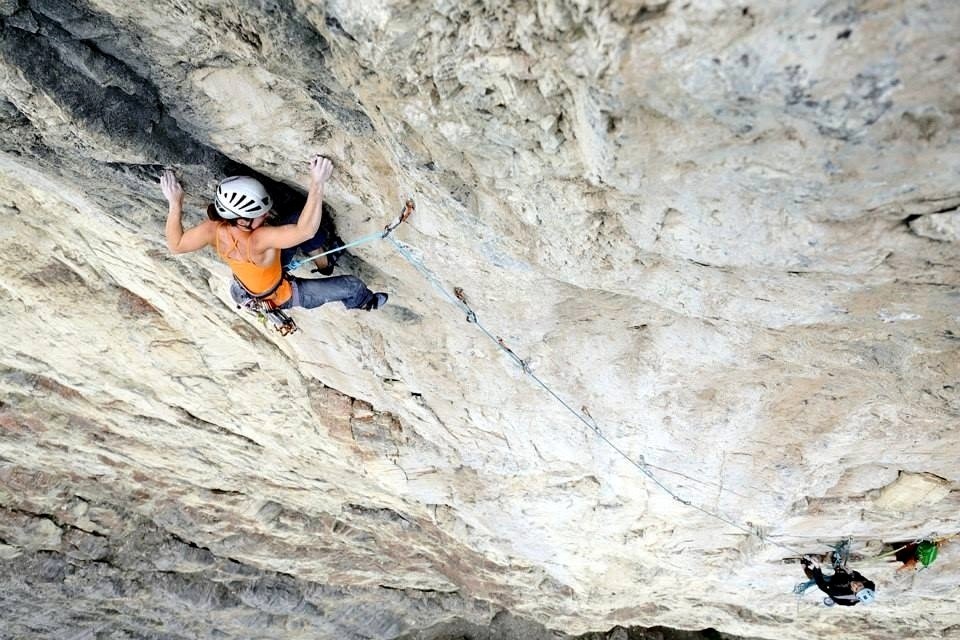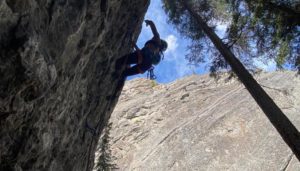Vikki Weldon on Being a Nurse During Covid-19 and Hard Sends
Based in Squamish, 5.14 climber Vikki Weldon shares some thoughts on life, climbing, comps, Covid-19 and her favourite ropes
 Photo by: Wiktor Skupinski of Vikki Weldon on Blue Jeans 5.13 on Yamnuska
Photo by: Wiktor Skupinski of Vikki Weldon on Blue Jeans 5.13 on Yamnuska
Vikki Weldon has been one of Canada’s top climbers for nearly two decades. She started climbing at nine in her hometown of Calgary, became a seven-time Canadian Youth National Champion and a three-time Canadian Open Bouldering Champion.
At the 15, she was climbing 5.13, and she’s since gone on to climb 5.14 sport, 5.13 trad, hard boulders and new routes around the world. She made the second ascent of Blue Jeans 5.13b on Yamnuska, and redpointed Spirit of the West, a 5.14a in Squamish Valley and Tom et Je Ris 5.14a in France. And she repeated Adder Crack 5.13 trad in Squamish, first climbed by Hazel Findlay. Abroad, she made the first ascent of Le Zahir in the Akchour Valley of Morocco, a seven-pitch 5.12b, with Paul McSorley; and the first ascent of the southwest buttress of Hidden Tower V 5.11 in Mythics Cirque, Greenland with Paul McSorley, Paolo Marazzi and Matthew Irving.
She told her rope sponsor Maxim, “Climbing is one of the most versatile sports in the world, from the dusty gym to the highest peaks in the world, there is always something different to experience and pursue.” We touched base with her via email at her home in Squamish.

What was it like growing up in a family of climbers? It was wonderful. I grew up in a big family, with three other very busy siblings. We had a lot of energy, and it was great that we all put it towards the same activity. My parents were always volunteering and putting in a lot of their own time, with my mom becoming an international route judge, and my dad involved in the higher-level organization of Competition Escalade Canada (CEC). Our lives revolved around climbing, and it has played a really positive role in the development of our relationships with each other.
Was there a lot of competition between the siblings? I think that we are a competitive bunch, however it has always been friendly and positive competition between us. We are all aged a few years apart, and so growing up, we were never in the same age categories in competitions, which is where we dedicated all of our competitive drive. Even when Stacey and I would compete together in adult competitions, we would push each other and strive to do our best, but it never became a negative aspect of our relationship with each other. In fact, between siblings, I think we have always had really positive relationships with climbing and each other. This has allowed us to push each other and really enjoy climbing together.
Is there a lot of climbing talk between the family? Oh, definitely. We all talk about climbing a lot. Climbing still plays a huge role in all of our lives, and it’s great that for my family, talking about climbing comes just as naturally as talking about the weather or other common day occurrences. Climbing is who we are.
What do you miss about competition climbing? To be honest, not a lot. I loved competition while I was involved in it, but I feel like my transition out of it happened at a perfect time, and I haven’t really looked back. There are really special things about competition climbing that I appreciate having good memories of, like the incredible relationships I built with my teammates, competitors and coaches, and that thrill of pushing hard and topping out a competition route or boulder. Competition climbing was how I started climbing, and I will always appreciate the influence it has had on my development as a climber.
Blue Jeans was a big send. What did it mean to make one of the early all-free ascents of the now famous Yamnuska climb? Blue Jeans will always stand out in my memory as a significant achievement in my climbing life. It was the first climb that I picked to project that was way beyond my ability and experience level, and that I dedicated more than one season to trying. I had to become a much better climber to complete this route, in all aspects: fitness, technique, rope management, learning how to multipitch, etc. The fact that it was an early ascent of the route is really just icing on the cake to a personal achievement that I will always cherish.
Was climbing a 5.14a sport route a goal growing up? Definitely. When I first started climbing outside and projecting sport routes at Acephale in the Bow Valley, I was always in awe of climbers sending those hard 5.14 routes. Watching climbers like Sonnie Trotter send Existence Mundane was early inspiration for me to try hard routes. It felt like a goal that was miles away at the time, and it honestly is still always a goal for me, except that now I know that I can achieve it if I put in the effort.
How many sessions did Tom et Je Ris take and what was that experience with Sean McColl and Mike Doyle like? The trip to the Verdon Gorge with Sean and Mike in 2016 was pretty incredible. Mike and I had been talking about going to try Tom et Je Ris for a long time, and when the opportunity came to go, we went all in for a quick two-week trip. Sean was living in France at the time and joined as well. I honestly didn’t think that I was going to send in such a short trip, but the route really suited my abilities and I think I did it in about 6 days. I was definitely the last of the trio to send (Both Sean and Mike did it in a handful of tries), and it was down to the wire, with a huge low pressure system moving in the next day. Mike and Sean were really amazing, they both came out and supported me each day after they sent, putting in long belays and Sean even got the full send on video. It was a really special, unique trip, and Tom et Je Ris is a route that will go down in history as one of my favourites. It was perfect.
There aren’t many Canadian who’ve climbed 5.13 trad. Are there other hard cracks out there that you have your eye on? I am really psyched to try some harder trad routes. There are so many gems around Squamish that I have my eye on. Last year I played on Going to California which is a beautiful line that I’d like to go back for. Another dream line is North Star, an incredible pitch right at the top of the Chief that has a hard boulder problem above gear as the crux. It’s one I’d love to try for sure.
Which one do you dream about more often: Yamnuska or The Chief? Yamnuska is a special cliff for me. It’s the first cliff that would always catch my eye when driving from Calgary into the mountains, and climbing Blue Jeans was a pivotal experience in my life. However, it really is the Chief that I dream of more. It’s my home, and there are so many routes that I want to climb on it. Both of these mountains have special places in my heart, and I do have a beautiful print of Yamnuska by Fraser McGurk in our living room that I admire every day.
What’s one good thing and one bad thing that happened in the world of being a nurse during Covid-19 for you? I never envisioned that the career path I chose would put me at the front lines of a pandemic. Over the past year, I have put my career as a nurse first, working hard with my colleagues to care for our community. I feel especially lucky to work in the emergency department at Lion’s Gate Hospital in North Vancouver. I am a part of a solid team that came together during an incredibly stressful time and has worked tirelessly to keep each other and our patients safe. The stress of the past year has really weighed hard on us all, and that chronic stress has played negatively on me at times. I try to be kind to myself and others, to be patient and understanding, and to focus on good self-care on my days off. I do think that front line health care workers will feel the effects of this stress and trauma long after the pandemic is over. Furthermore, I am ever so grateful to be surrounded by a team that is supportive and takes care of each other.
A short film on paramedic Jerome Mowat (watch the trailer) talked about how climbing helped during the early stages of Covid-19. Has climbing helped you during the pandemic? My relationship with climbing has been quite tumultuous during the pandemic. Last spring, while we were bracing for the impact of the virus that we were seeing happen in Europe, climbing was being viewed and toted as an irresponsible activity that could potentially add strain to the health care system due to potential injuries and risk of transmission of the virus. It was so stressful to have this sport that I have dedicated my life to be so socially unacceptable. When the threat of that influx of Covid-19 cases dwindled and climbing became acceptable again, I found solace and comfort in the sport that I’ve known for my whole life. While work was stressful and every day brought new policies and practice changes, I knew I could count on climbing as my escape. However, I didn’t push for big projects or objectives last year. Instead, I sought out flow and volume, climbing multi-pitches and choosing achievable objectives. This really helped me find some balance in such an unbalanced time.
For big whippers, what’s your favourite rope to use? The Maxim Airliner 9.1 mm 80 m is my go-to rope for working routes and taking those repeated, big falls. It’s such a workhorse rope, and lasts longer than any other rope I’ve ever used.
What rope would you go with for a day of cragging, and what rope(s) for a multi-pitch? For a day of cragging, I’ll bring my Maxim Airliner, for its durability and relatively light weight. For multipitching, I love the bi-pattern Maxim Pinnacle 9.5 mm 60 m. The bi-pattern makes it easy to find the midway, and it’s a durable, lightweight rope that performs well multi-pitching. Another rope that I quite like is the Maxim Platinum 9.8 mm. This rope is unique, as it weaves the core and sheath of the rope together, making it incredibly durable. I choose the Platinum when I’m headed on bigger objectives, such as alpine climbing, when encountering sharp edges and harsher terrain is more likely.
You’ve climbed some big new routes around the world. If everything went back to pre-pandemic times, where would you travel for another adventure? I am so keen for another European climbing trip: France, Spain and Greece are all high on the list.
You’ve been a top Canadian climber for nearly two decades. What advice do you have for young climbers out there? Find what makes you the happiest in climbing, and do that. This is such a diverse sport with so many modalities. You don’t need to fit within any mold. You also don’t need to stick with just one form of climbing. I feel like my longevity in the sport is due to that fact that I like to mix it up. Be open to learning new things, respect your mentors and experienced climbers in the community, and always bring a positive attitude to any situation.


